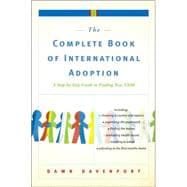
What is included with this book?
DAWN DAVENPORT is the mom of four through both birth and international adoption. She is the international adoption expert for Resolve, the national infertility support organization, and has been interviewed by NPR, 60 Minutes, and Primetime Live. She lives in Brevard, North Carolina.
| My Prayer for All Children | ix | ||||
| Acknowledgments | xi | ||||
| Introduction | xv | ||||
| CHAPTER 1: IS INTERNATIONAL ADOPTION RIGHT FOR YOU? | |||||
|
1 | (31) | |||
| CHAPTER 2: DECIDING ON A COUNTRY | |||||
|
32 | (37) | |||
| CHAPTER 3: DECIDING ON AN AGENCY | |||||
|
69 | (30) | |||
| CHAPTER 4: AFFORDING ADOPTION | |||||
|
99 | (12) | |||
| CHAPTER 5: SURVIVING THE HOME STUDY | |||||
|
111 | (19) | |||
| CHAPTER 6: PREPARING THE PAPERWORK | |||||
|
130 | (25) | |||
| CHAPTER 7: SURVIVING THE WAIT | |||||
|
155 | (29) | |||
| CHAPTER 8: THE REFERRAL AND MEDICAL EVALUATION | |||||
|
184 | (38) | |||
| CHAPTER 9: MEETING YOUR CHILD | |||||
|
222 | (44) | |||
| CHAPTER 10: BACK HOME | |||||
|
266 | (64) | |||
| RESOURCE GUIDE | 330 | (52) | |||
| APPENDIX 1: COUNTRY CHARTS | 382 | (1) | |||
| APPENDIX 2: REFERENCE/RESEARCH | 382 | (5) | |||
| APPENDIX 3: GLOSSARY OF ADOPTION AND INTERNET ACRONYMS | 387 | (3) | |||
| Index | 390 |
The New copy of this book will include any supplemental materials advertised. Please check the title of the book to determine if it should include any access cards, study guides, lab manuals, CDs, etc.
The Used, Rental and eBook copies of this book are not guaranteed to include any supplemental materials. Typically, only the book itself is included. This is true even if the title states it includes any access cards, study guides, lab manuals, CDs, etc.
Excerpted from The Complete Book of International Adoption: A Step by Step Guide to Finding Your Child by Dawn Davenport
All rights reserved by the original copyright owners. Excerpts are provided for display purposes only and may not be reproduced, reprinted or distributed without the written permission of the publisher.